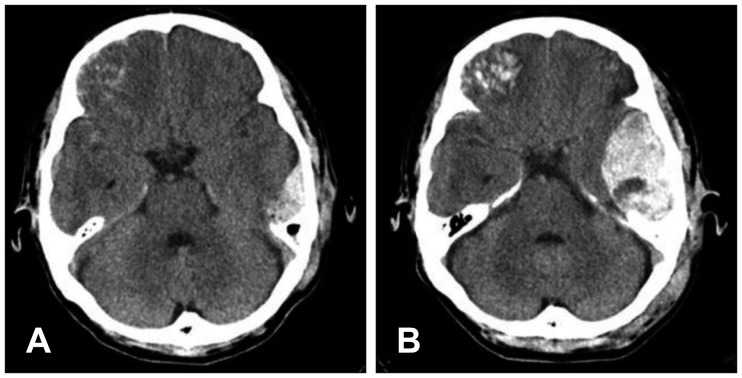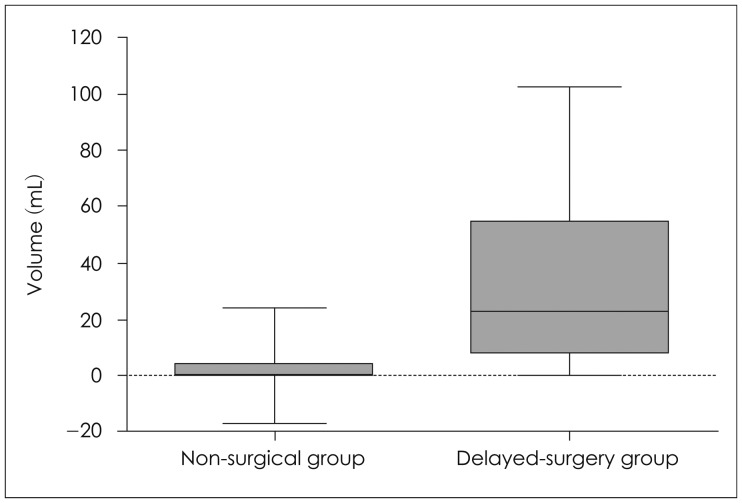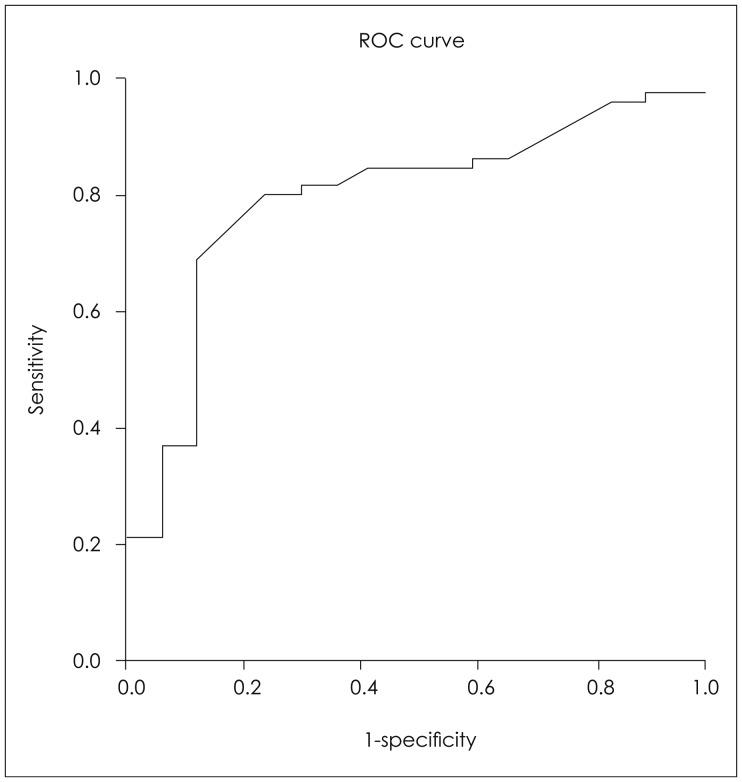Korean J Neurotrauma.
2015 Oct;11(2):112-117. 10.13004/kjnt.2015.11.2.112.
Clinical Analysis of Delayed Surgical Epidural Hematoma
- Affiliations
-
- 1Department of Neurosurgery, Wonju College of Medicine, Yonsei University, Wonju, Korea. nsojw@yonsei.ac.kr
- KMID: 2378268
- DOI: http://doi.org/10.13004/kjnt.2015.11.2.112
Abstract
OBJECTIVE
A small epidural hematoma (EDH) that has been diagnosed to be nonsurgical by initial brain computed tomography (CT) can increase in size and need surgical removal, resulting in a poor prognosis. However, there have been few studies, which focused delayed operated EDH. Therefore, we analyzed the clinical factors to determine the predicting factors of delayed operated EDH.
METHODS
Between January 2011 and January 2014, 90 patients, who were admitted due to EDH, were enrolled in this study. None of the patients were indicated for operation initially. Based on the presence of surgery, we classified the patients into a delayed-surgery group (DG) and a non-surgical group (NG). Additionally, we analyzed them according to the following: time interval between the trauma and the initial CT, gender, age, medical history, drinking, change of mean arterial pressure (MAP), volume of EDH and other traumatic brain lesion.
RESULTS
Among the 90 patients, the DG was 19 patients. Compared with NG, the DG revealed increased MAP, less presence of drinking, and a short time interval (DG vs. NG: +9.684 mm Hg vs. -0.428 mm Hg, 5.26% vs. 29.58%, 1.802 hours vs. 5.707 hours, respectively, p<0.05). Analyzing the time interval with receiver operating characteristic, there was 88.2% sensitivity and 68.3% specificity at the 2.05-hour cut-off value (area under the curve=0.854).
CONCLUSION
According to our results, the time interval between the trauma and the initial CT along with blood pressure change are potential predicting factors in the cases of delayed operation of EDH.
Keyword
MeSH Terms
Figure
Cited by 1 articles
-
Rapid Redistribution of an Acute Traumatic Epidural Hematoma in a Patient with Invasive Skull Cancer
Hyunnyung Lee, Sun-Chul Hwang, A Leum Lee, Chan-Gyu Kim, Soo Bin Im
Korean J Neurotrauma. 2018;14(2):138-141. doi: 10.13004/kjnt.2018.14.2.138.
Reference
-
1. Araujo JL, Aguiar Udo P, Todeschini AB, Saade N, Veiga JC. Epidemiological analysis of 210 cases of surgically treated traumatic extradural hematoma. Rev Col Bras Cir. 2012; 39:268–271. PMID: 22936224.2. Bae DH, Choi KS, Yi HJ, Chun HJ, Ko Y, Bak KH. Cerebral infarction after traumatic brain injury: incidence and risk factors. Korean J Neurotrauma. 2014; 10:35–40.
Article3. Bezircioğlu H, Erşahin Y, Demirçivi F, Yurt I, Dönertaş K, Tektaş S. Nonoperative treatment of acute extradural hematomas: analysis of 80 cases. J Trauma. 1996; 41:696–698. PMID: 8858030.4. Bullock MR, Chesnut R, Ghajar J, Gordon D, Hartl R, Newell DW, et al. Surgical management of acute epidural hematomas. Neurosurgery. 2006; 58(3 Suppl):S7–S15. discussion Si-SivPMID: 16710967.
Article5. Chen H, Guo Y, Chen SW, Wang G, Cao HL, Chen J, et al. Progressive epidural hematoma in patients with head trauma: incidence, outcome, and risk factors. Emerg Med Int. 2012; 2012:134905. PMID: 23320175.
Article6. Greenspan L, McLellan BA, Greig H. Abbreviated Injury Scale and Injury Severity Score: a scoring chart. J Trauma. 1985; 25:60–64. PMID: 3965737.7. Haselsberger K, Pucher R, Auer LM. Prognosis after acute subdural or epidural haemorrhage. Acta Neurochir (Wien). 1988; 90:111–116. PMID: 3354356.
Article8. Heinzelmann M, Platz A, Imhof HG. Outcome after acute extradural haematoma, influence of additional injuries and neurological complications in the ICU. Injury. 1996; 27:345–349. PMID: 8763290.
Article9. Hu TT, Yan L, Yan PF, Wang X, Yue GF. Assessment of the ABC/2 Method of Epidural Hematoma Volume Measurement as Compared to Computer-Assisted Planimetric Analysis. Biol Res Nurs. 2015; [Epub ahead of print].
Article10. Hukkelhoven CW, Steyerberg EW, Rampen AJ, Farace E, Habbema JD, Marshall LF, et al. Patient age and outcome following severe traumatic brain injury: an analysis of 5600 patients. J Neurosurg. 2003; 99:666–673. PMID: 14567601.
Article11. Knuckey NW, Gelbard S, Epstein MH. The management of "asymptomatic" epidural hematomas. A prospective study. J Neurosurg. 1989; 70:392–396. PMID: 2915245.12. Lee EJ, Hung YC, Wang LC, Chung KC, Chen HH. Factors influencing the functional outcome of patients with acute epidural hematomas: analysis of 200 patients undergoing surgery. J Trauma. 1998; 45:946–952. PMID: 9820707.13. Marino R, Gasparotti R, Pinelli L, Manzoni D, Gritti P, Mardighian D, et al. Posttraumatic cerebral infarction in patients with moderate or severe head trauma. Neurology. 2006; 67:1165–1171. PMID: 17030747.
Article14. Murzin VE, Goriunov VN. [Study of the strength of the adherence of the dura mater to the bones of the skull]. Zh Vopr Neirokhir Im N N Burdenko. 1979; 43–47. PMID: 484154.15. Oertel M, Kelly DF, McArthur D, Boscardin WJ, Glenn TC, Lee JH, et al. Progressive hemorrhage after head trauma: predictors and consequences of the evolving injury. J Neurosurg. 2002; 96:109–116. PMID: 11794591.
Article16. Rivas JJ, Lobato RD, Sarabia R, Cordobés F, Cabrera A, Gomez P. Extradural hematoma: analysis of factors influencing the courses of 161 patients. Neurosurgery. 1988; 23:44–51. PMID: 3173664.
Article17. Sullivan TP, Jarvik JG, Cohen WA. Follow-up of conservatively managed epidural hematomas: implications for timing of repeat CT. AJNR Am J Neuroradiol. 1999; 20:107–113. PMID: 9974064.




